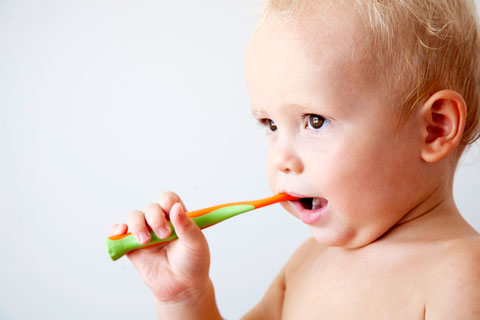Strong baby teeth are essential to a child’s health. Families can help promote healthy dental care habits and prevent childhood tooth decay.
Practice daily dental care
- Gently wipe a baby’s gums with water twice a day before they have teeth. Use a clean, damp piece of gauze, washcloth, or soft infant toothbrush with water. This time can be pleasant if you smile and talk to them: “This is how we clean your mouth!”
- For toddlers and preschoolers, go shopping together to select a fun child-sized toothbrush in their favorite color. Brush their teeth very gently twice a day, starting when their first tooth comes in.
- Ask the dentist when to use toothpaste. Your preschool-aged child may be ready when they understand how to spit out toothpaste in the sink after brushing, rather than swallowing it. Together, select a children’s toothpaste in a flavor they enjoy. Just use a pea-sized amount of toothpaste each time you brush.
- Be a good model! Let your child see you brush and floss regularly.
Protect your child from tooth decay
Everyone, even babies, can get tooth decay. If you see brown or black spots on your child’s teeth, that is a sign of decay. The good news is that there are ways to prevent tooth decay.
- With infants, gently take them from the breast or take the bottle from their mouth as soon as possible if they fall asleep while feeding. If the bottle or breast stays in their mouth while sleeping, the liquid can pool around their teeth.
- Avoid sugary food and drinks, which can damage the teeth and cause cavities.
- Teach your child to drink water or milk from a cup or spill-proof cup after their first tooth appears. They need practice drinking out of cups to be successful!
Prepare for your child’s first dentist visit
- Ask other parents or your health care provider to recommend a dentist. Many family dentists and pediatric dentists specialize in working with babies and children.
- Some dentists may want to see a child when the first tooth erupts at 6–12 months. Others may want to wait until the child’s first birthday or later.
- Before the visit, share picture books about teeth and dentists. You can help your child get used to opening their mouth for the dentist by playing “How Many Teeth?” and other “open mouth” games. A toddler or preschooler may want to pretend play “dentist’s office.”
- At the visit, bring along books and comfort toys. Arrive a bit early so you and your child can look around and meet the staff. Expect to stay with your child during the checkup.


 PDF
PDF